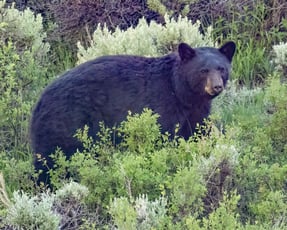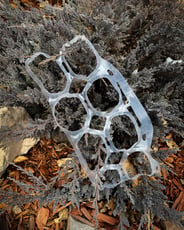This Time of Year, Black Bears are Hungry!
Most people in Colorado have never seen a black bear in the wild. In 2016 the Colorado Parks and Wildlife (CPW) estimated the population of black bears in Colorado to be between 17,000 to 20,000 bears.
A rare few people have had encounters that caused injury or were fatal. At least six people have been killed by bears in Colorado since 1934. Your chances of being injured or killed by a black bear in Colorado are very, very low.
Bears-in-Wildridge-search-for-food-in-trash-cans-left-outside.
American black bears (Ursus americanus) are black, however they can be black, brown, blond, cinnamon, and even white. The “spirit bear,” also called the Kermode bear, is a subspecies of the American black bear that lives in the Central and North Coast regions of British Columbia, Canada. A recessive gene creates the white color, but they are not albinos.
Grizzly bears inhabited Colorado in the past but, during the 1940s and 50s, a government-funded program reduced their population and around 1952, it was decided that grizzlies had been eliminated from Colorado. Some however argue they are still in the state. In 1979 an archer inadvertently approached a sleeping bear and was attacked outside of Pagosa Springs. The bear was identified as a grizzly.
You are much more likely to see black bears this time of year than any other. Black bears are typically active from about mid-March until November, when they return to hibernation. This time of year, they are consuming about 20,000 calories a day to gain enough fat to survive the winter. How many apple pies does it take to get to 20,000 calories? A 9” apple pie contains around 3000 calories. How many humans could consume 6 or more pies in a single day? Another comparison is the calorie content of 36 Big Macs!
For bears, this need for calories is called hyperphagia. Failure to obtain those calories might cause a bear to not make it through the winter. For females that give birth during hibernation, they may not produce enough milk to wean their cubs.
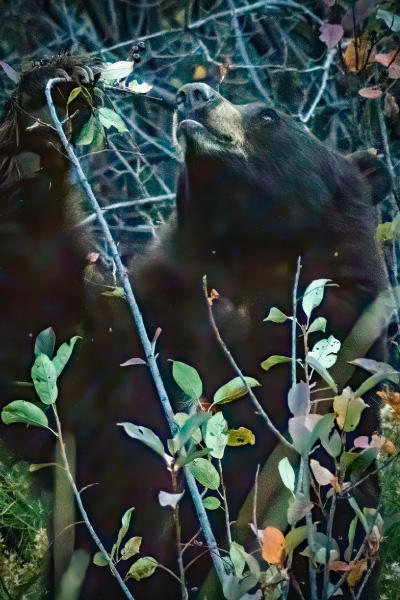
A black bear obtains calories from some berries from a bush in the fall.
Next time you are hiking a trail, look around and see if you can even find 20,000 calories. Of course you don’t have the nose of a black bear! Bears obtain those calories from eating carrion, tubers, nuts, and berries. If you are a black bear, that is what you are after every day from mid-August until around late September or October. That time frame is moving into November due to climate change. In most years, bears in the “backcountry” usually find enough food without difficulty.
Bears face a possible fatal situation when they find themselves around humans. A bear can smell food from five miles away, according to the CPW, and once they find a source of food, they'll remember that source. If that source is food carelessly left out by humans, bears simply look at is as easy calories. They come back looking for more.
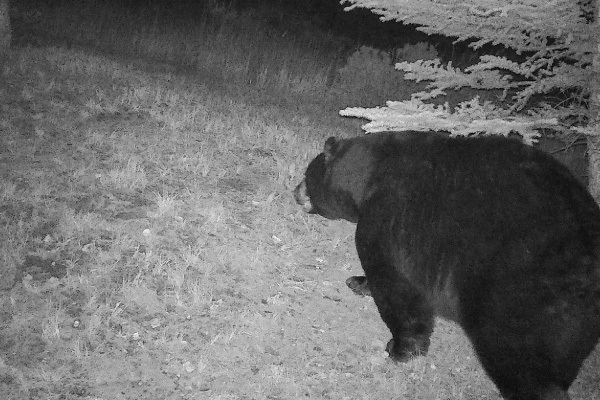 A trail cam is triggered in Wildridge in early morning in the fall by a large black bear.
A trail cam is triggered in Wildridge in early morning in the fall by a large black bear.
What do humans leave out for bears? Food for their dogs and cats, bird seed for the birds, BBQs that are not cleaned, are all quick easy calories for bears. In addition, many people don’t lock their doors or close their windows. Bears can smell the food inside the house. Remember that they can climb trees, so that post holding up your deck is not much different.
Humans also leave food in their cars, they have trash cans that are left outside, or on trash days they leave the trash cans at the curb overnight. Bears often find these food sources and start returning, night after night, looking for more. When they still need more calories, they are out before dark and stay out after sunrise. That is when we are more likely to see them.
Some think that there is a Colorado Parks and Wildlife directive on black bear incidents that has the phrase “two-strikes” and you are out. This baseball game analogy is not correct and CPW personnel do not relocate or destroy bears as some form of penalty. It has more to do with bears that are currently judged to be dangerous because of their location or activity. Bears that break into cars or houses can be dangerous for the people who live in that area. Campsites that are not kept clean by users can create similar problems.
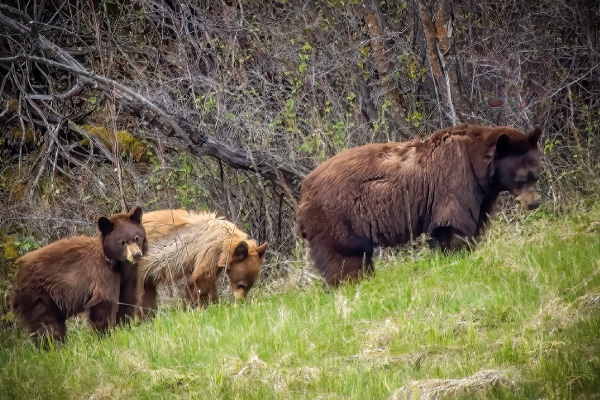 A sow and two yearling cubs on Derby Road illustrate the color variation in these bears.
A sow and two yearling cubs on Derby Road illustrate the color variation in these bears.
Removing problem bears from areas does not always resolve the situation. When bears are released, they may return to the capture location within weeks, if not days. Moving a bear away from a town before it becomes a chronic problem does not always work. Bears that have been relocated hundreds of miles away have returned to the capture location within weeks, if not days.
Even after being taken large distances, they may pose a different problem. They find another town where they resort to their old ways. That town now has the problem with that bear.
Bears that become a major nuisance or danger may be euthanized. Your behavior may contribute to a bear’s death or invite a dangerous encounter.
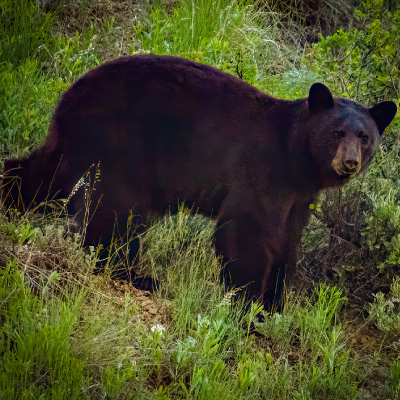 Bears find calories in bushes in the fall.
Bears find calories in bushes in the fall.
What can you do to avoid conflicts and keep wild bears wild?
• Put your trash in bear-proof containers, and don’t put it out until just before pickup.
• Don’t leave dog or cat food outside.
• Bring in bird feeders at night.
• Burn food off your barbecue grills and clean them after each use.
• Lock the doors and windows to your house.
• Don’t feed bears or other wildlife that might attract bears.
• Pick fruit before it ripens from trees in your yard and clean up fallen fruit.
• Talk to your neighbors about doing their part to be bear responsible.
• When camping, store food in air-tight containers or in your trunk.
• Keep a clean tent and campsite.
• Lock your vehicle. Bears often get into vehicles, the door closes, and they cannot get out. The interior will be unrecognizable when the bear is done with it. Do you want to open the door?
If you do happen upon a bear – or it happens upon you – stay calm. According to CPW, bears aren't naturally aggressive, and are often wary of people, with their normal response being to run away from potential danger.
Here are some tips on what to do if you encounter a bear:
• Never run. Running can make a bear chase you.
• Keep your distance. Back slowly away, facing the bear. Avoid direct eye contact.
• Slowly and calmly leave the area. Talk aloud so the bear will become aware of you.
• Be extra careful around a female with cubs. Never approach a cub.
• Never throw food to distract a bear.
Are you doing all you can to prevent an issue with a bear? Let’s all do our part to keep bears safe and wild.
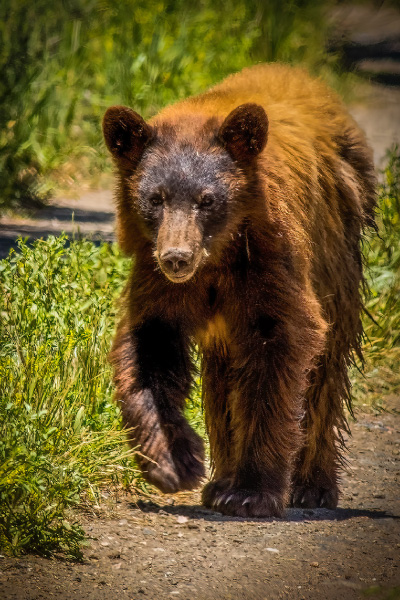
A young black bear, is now on its own in the summer on the Colorado River Road.

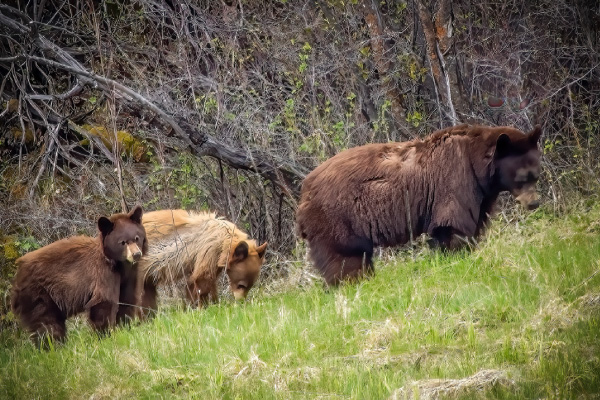
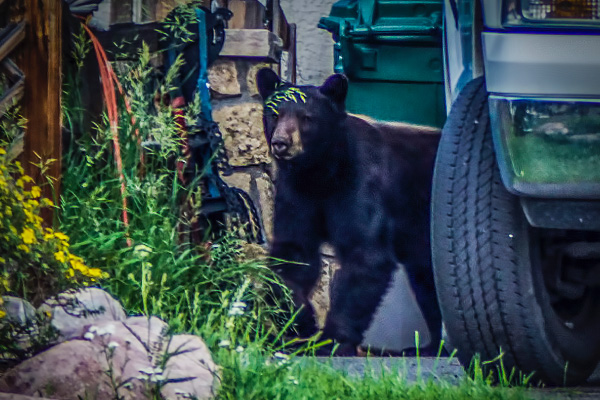

 A trail cam is triggered in Wildridge in early morning in the fall by a large black bear.
A trail cam is triggered in Wildridge in early morning in the fall by a large black bear. A sow and two yearling cubs on Derby Road illustrate the color variation in these bears.
A sow and two yearling cubs on Derby Road illustrate the color variation in these bears. Bears find calories in bushes in the fall.
Bears find calories in bushes in the fall.

